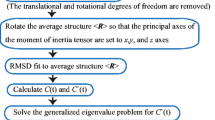Abstract
A dynamic model applicable to biomolecular structures for understanding the dynamics and the vibrational behaviors of protein is considered. A mechanical mass-spring model represented by point masses and harmonic springs is presented. The biomolecular structure may be envisioned by a mass and spring system with multi-degrees-of-freedom because dominant atoms in protein may be considered to be point masses, and bonding and non-bonding interactions between atoms of interest and surrounding atoms within some critical distances are implemented by a spring. Furthermore, a model condensation scheme is to be introduced because most proteins have large degree of freedom requiring large computation time and memory, which results in reducing computational cost and maintaining the accurate predictions. From solving the corresponding eigenvalue problem constructed from a multi-degree-of-freedom system, our results show the modified mechanical spring-mass model of a biostructure through a condensation scheme is very successful in predicting the dynamics of molecular structures in terms of thermal fluctuations and eigenmode, etc.
Similar content being viewed by others
References
Q. Cui, G. Li, J. Ma and M. Karplus, A normal mode analysis of structural plasticity in the biomolecular motor F (1)-ATPase, J. Mol. Biol. 340(2) (2004) 345–372.
F. Tama and Y. H. Sanejound, Conformation change of proteins arising from normal mode calculations, Protein Eng. 14 (2001) 1–6.
J. Ma and M. Karplus, Ligand-Induced conformational changes in ras p21: a normal mode and energy minimization analysis, J. Mol. Biol. 274 (1997) 114–131.
F. Tama, F. X. Gadea, O. Marques and Y. H. Sanejouand, Building block approach for determining low-frequency normal modes of macromolecules, Proteins: Structure, Function, and Genetics 41(1) (2000) 1–7.
J. H. Weiner, Statistical Mechanics of Elasticity, Dover Publications, INC., 2nd ed. (2002).
M. P. Allen and D. J. Tildesley, Computer Simulation of Liquids, Oxford University Press (1989).
M. M. Tirion, Large amplitude elastic motions in proteins from a single-parameter atomic analysis, Phys. Rev. Lett. 77 (1996) 1905–1908.
D. Ming, Y. Kong, Y. Wu and J. Ma, Simulation of F-Actin filaments of several microns, Biophysical Journal 85 (2003) 27–35.
B. Erman, The gaussian network model: precise prediction of residue fluctuations and application to binding problems, Biophysical J. (91) (2006) 3589–3599.
J. Trylska, V. Tozzini and J. A. McCammon, Exploring global motions and correlations in the ribosome, Biophys. J. 89 (2005) 1455–1463.
T. Haliloglu, I. Bahar and B. Erman, Gaussian dynamics of folded proteins, Phys. Rev. Lett. 79 (1997) 3090–3093.
L. Meirovitch, Computational methods in structural dynamics, Sijthoff and Noordhoff, (1980).
Author information
Authors and Affiliations
Corresponding author
Rights and permissions
About this article
Cite this article
Eom, K., Ahn, JH., Kim, JI. et al. Modified mechanical mass-spring model of biomolecules for understanding dynamics of proteins. J Mech Sci Technol 22, 506–513 (2008). https://doi.org/10.1007/s12206-007-1202-7
Received:
Revised:
Accepted:
Published:
Issue Date:
DOI: https://doi.org/10.1007/s12206-007-1202-7




